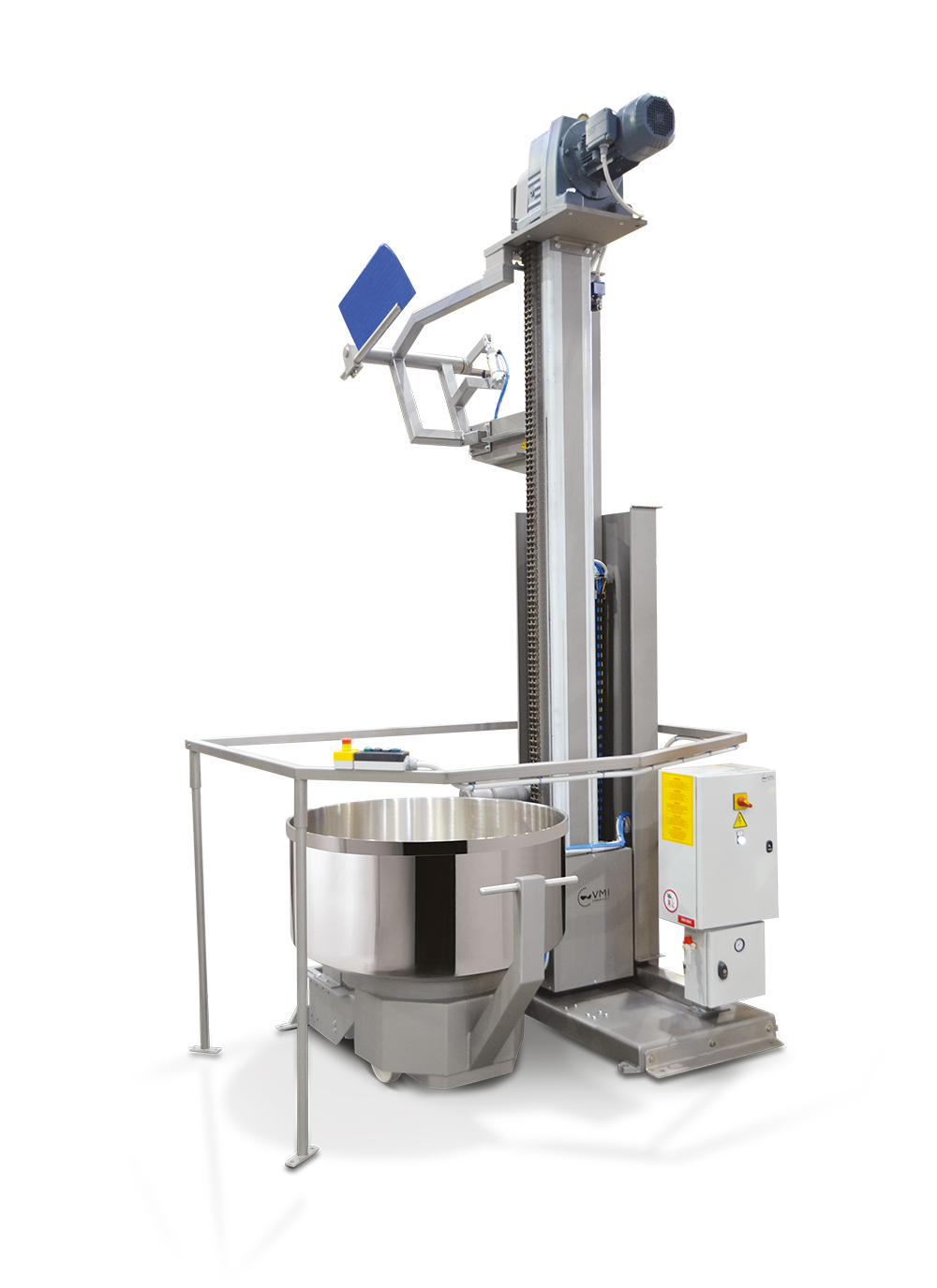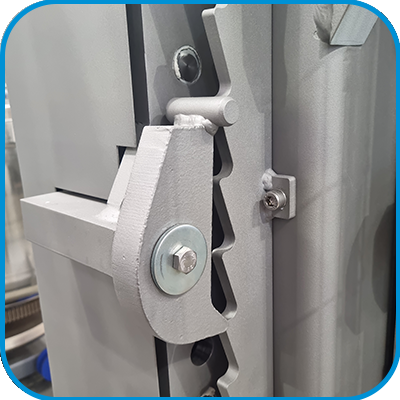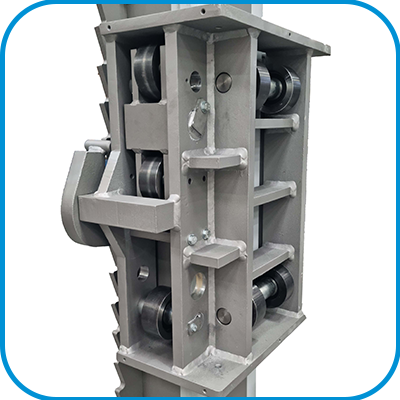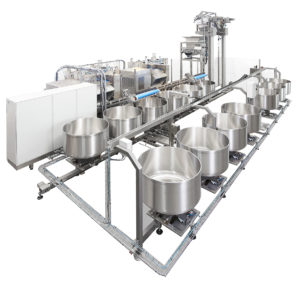In the bakery and pastry industry, adding a new tool to your laboratory, in addition to your mixer, can help you improve your productivity. This is particularly true with bowl lifts that take over once the kneading work is completed. The mixer bowl is picked up and elevated and the dough is discharged by a controlled rotational movement.

The operating principle of bowl lifts is the lifting and lowering of loads. As a result, they are legally classified as lifting devices and accessories and are subject to strict control and safety requirements.
VMI recommends a few best practices for detecting signs of wear and tear early on and securing and maintaining your equipment.
Safety measures specific to bowl lifts
Lifting equipment may need to be thoroughly examined at periods as specified in government regulations. They must undergo a general inspection at least every 12 months. In some cases, this period can be shortened to six months.
Maintenance must be performed by a competent person using the proper tools and in accordance with safety regulations.
These requirements are not to be taken lightly; they are essential to:
- Ensure the safety of staff and goods
- Detect signs of wear and tear as soon as possible to limit the downtime of your equipment
- Guarantee regulatory compliance of your equipment
Best Practice #1: Check your equipment regularly
Periodic checks must be conducted on your bowl elevators throughout their lifecycle to ensure safety and performance.
Before you start
Before you start using your bowl lift, you must check that the equipment is set up according to the manufacturer’s instructions. You should make sure the equipment has been installed properly, is stable, and is not in a location where others may be exposed to risk. A competent person then performs tests with loads to ensure that the equipment runs smoothly and that safety measures are functioning correctly.
Periodic thorough examination
A systematic and detailed examination of the lifting equipment must be performed by a competent person at regular intervals (usually every 6 to 12 months). We recommend that you check your country’s regulation for the terms and required frequency of this inspection.
These checks must be performed by qualified and competent professionals. It can be a member of your staff with relevant knowledge or someone from another organization.
The process takes place in two stages. First, a visual inspection of the machine is performed to determine its condition and any signs of degradation. In the second stage, the verifier runs tests to ensure that specific parameters are working properly. These are mostly safety features like the emergency stop button.
Recommended routine checks
In addition to these mandatory checks, a daily visual inspection is highly recommended but very often overlooked. This inspection can be essential to detect and solve defects before they have an impact on your productivity.
Best Practice #2: Know what parameters to monitor and recognize warning signs
During the mandatory periodic inspection, the qualified technician follows a checklist. There are several elements on this list that are critical to the safety of your installation.

Check for chain wear
You must check the condition of the chain at least every year with a professional chain wear gauge. It’s necessary to monitor chain elongation accurately as it is the most common cause of chain failure.
You can tell if your chain needs to be replaced by following these elongation guidelines:
< 1,5%: your chain is in good working order, and you don’t need to replace it.
>1,5% : red flag. If the measure has been done during the mandatory inspection, you must add it to the report and specify that the chain needs to be replaced. You should plan its replacement with your maintenance team.
> 2%: alert threshold. You must replace the chain immediately to continue working safely.

Inspection of the parachute ratchet and rack
The parachute ratchet prevents the accidental free fall of the bowl in case of chain breakage. The blocking system is activated when the speed exceeds a predefined value. The parachute ratchet then locks into the rack to stop the fall. It is therefore imperative to ensure the proper operation of this device by checking the mobility of the parachute and its alignment with the chain and the rack. An inspection of the rack teeth is also recommended to make sure none of them are broken or rounded.

Inspection of the rollers
The rollers on the elevator cursors are wearable components. They must be examined on a regular basis to ensure that they are properly positioned. If they show signs of wear, they must be replaced.
Best Practice #3: Identify other signs of wear
The checks carried out during the annual examination are essential to determine the general state of wear of the lifting equipment and plan maintenance operations. You should also be alert to several other indicators during daily use:
- Chain pins that are twisted or have moved
- A chain that has been damaged by an external cause such as impact
- A broken chain due to excessive lifting or lack of lubrication
- Jammed or damaged chain links (such as cracks due to corrosion or metal wear)
- Mechanical parts (fork, fork link, lifting base) with cracks or crazing due to overload or shocks
These types of incident pose a significant risk to your installation and require the assistance of a maintenance technician. You can also contact the manufacturer, who will be able to advise you on the precautions to take to ensure safe operation.
Best Practice #4: Understand the factors that accelerate wear and tear on your equipment
Some factors related to your use or field of activity increase the wear rate of your bowl lifts. They also impact the required frequency of routine maintenance operations such as lubrication.
Use frequency and intensity
Heavy use can impact the frequency of maintenance required to keep your equipment running smoothly. The heavier the loads lifted, the greater the strain on the chain and mast. Also, frequent lifting will cause the chain to deteriorate more quickly, which can lead to chain elongation or even breakage if the loads lifted exceed the maximum recommended weight.
Operating conditions and work environment
Some work environments, like the food industry, can cause premature wear. Industrial food manufacturers or bakers must deal with dough residues or flour dust which can clog the lifting mechanism and block regular functioning. Hot or humid environments can also accelerate the degreasing of the chain.
Impacts
If your elevator is subjected to shocks or if your chains hit obstacles, the impacts can cause unexpected damage to your equipment and require repair or early replacement.
Choice of cleaning technologies
The cleaning method used by your staff can be a major factor in wear and tear. Some detergents are abrasive and will damage your elevator. In addition, cleaning with a water jet degreases the chain more quickly. To avoid incidents, we recommend using the grease or lubricant recommended by the manufacturer.
The importance of maintenance for optimal performance
Ancillary systems such as bowl lifts can be necessary for the smooth running of your manufacturing processes, especially in large-scale production. Thanks to their great versatility, bowl lifts are suitable for small production laboratories as well as industrial manufacturers in the bakery and snack-food sectors. Ensuring proper functioning is therefore essential to guarantee the performance of your production.

Regular inspection and maintenance are often a guarantee of long-term performance. Following these best practices will also allow you to significantly extend the life of your equipment and limit breakdowns that can impact your productivity.
You can maximize the productivity of your entire installation by maintaining your devices, whether they are elevators, planetary mixers, or kneaders!

